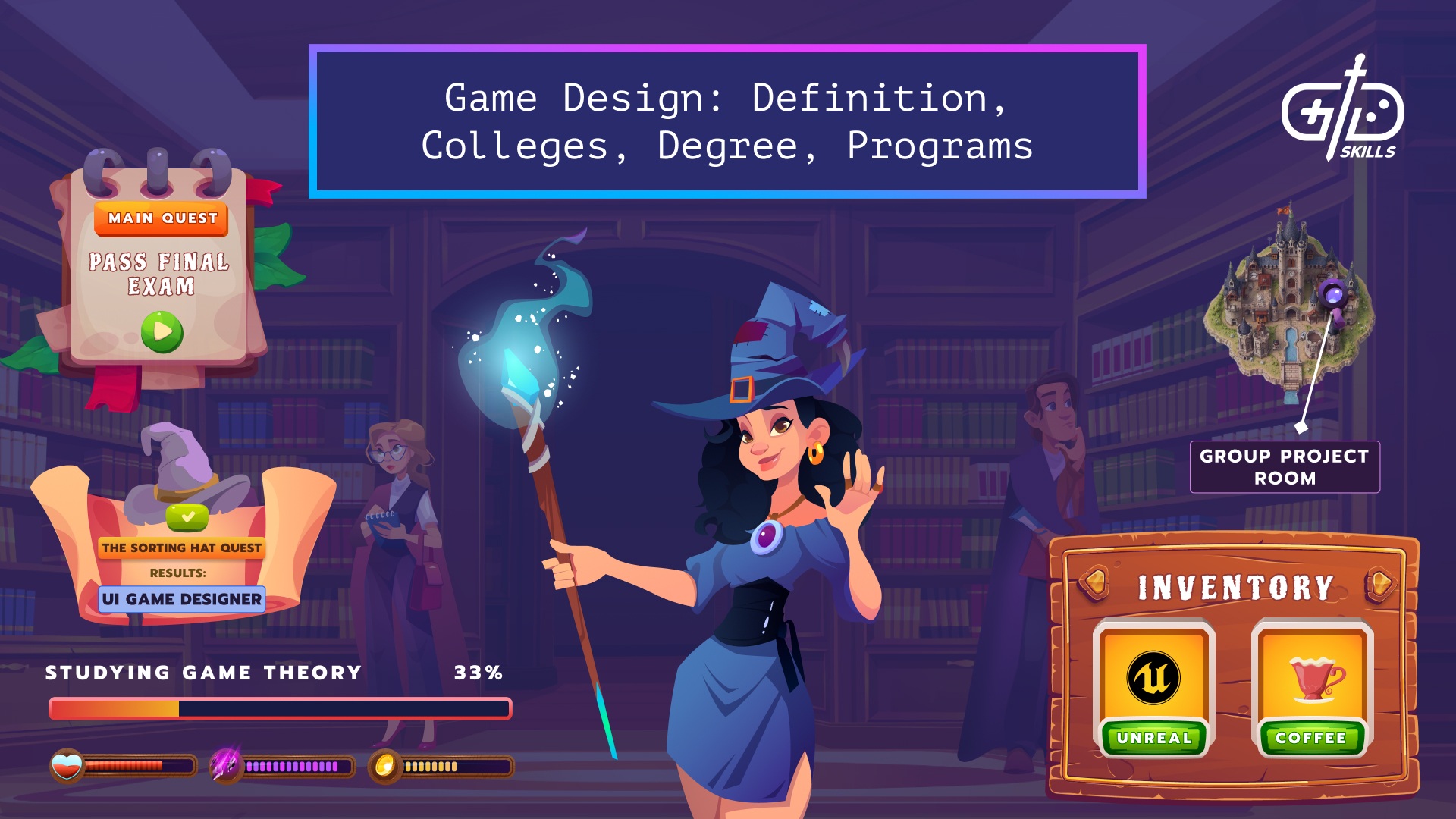Game design is a process blending storytelling, art, technology, and psychology to ideate, refine, and balance interactive experiences. Game design shapes players’ experience of a game, whether you’re looking to create intricate mechanics, build compelling worlds, or bring new characters to life. Understanding game design principles and how to apply them becomes increasingly important as the game industry grows. Colleges offer game design degree programs to teach the skills needed to succeed in the industry. I discuss game design education from top-ranked degree programs to alternative routes like online courses and portfolio building below. Learn about what game design is, what degree you need for the field, what the best available courses are, and the history of video game design.
What is game design?
Game design is the process of creating and refining the gameplay, rules, story, mechanics, characters, environments, and overall user experience of a computer game. The field of game design incorporates computer science, art, storytelling, and psychology to create interactive entertainment. Game designers create the vision for a project by coming up with playable characters, NPCs, and factions, establishing game mechanics, rules, and systems, and building a world where the action can take place. Creating games is an iterative process, and designers must be involved at each stage of the game development pipeline to ensure the original vision is adhered to as closely as possible.

The game design process breaks down into the 6 subcategories below.
- Gameplay design. Player interactions, rules, challenges, and gameplay mechanics are part of gameplay design. Gameplay design defines how your game is played, what the objectives are, and what constitutes success or defeat.
- Level design. Level design involves creating the environments where gameplay takes place. Designers must consider pacing, player pathfinding, and difficulty when building levels.
- Narrative design. Narrative design is the process of creating the story, dialogue, characters, world, factions, and conflicts of your game. Without a compelling emotional reason to engage, many players won’t stick with a game to completion.
- User experience/User interface (UX/UI) design. The menus, HUDs, controls, and general feel of navigating the game’s systems are part of UX/UI design.
- Art and sound design. The aesthetic design of your characters, game world, and assets must match the tone and theme of the experience. The sounds and music must add to the game’s theme and feel in the same way.
- Systems and balance design. Difficulty levels, economy design, and player progression must be designed and refined by the team to create an engaging experience that evolves over time.
What are the best colleges for game design?
The best colleges for game design are the University of Southern California (USC), New York University (NYU), the University of Utah, Rochester Institute of Technology (RIT), and the Savannah College of Art and Design (SCAD). USC’s Interactive Media & Games program features top faculty, deep game industry connections, and proximity to major AAA and AA studios. Notable alumni from USC’s program include employees at EA, Naughty Dog, and Activision.
The University of Utah offers an Entertainment Arts and Engineering (EAE) program that focuses on the technical and creative aspects of game design and consistently ranks among the best game design programs nationally. RIT’s BS in Game Design and Development is highly rated for its hands-on, project-based learning and deep ties to the industry. SCAD offers BFA, MA, and MFA courses through its Interactive Design and Game Development program. SCAD’s program focuses on storytelling, narrative systems, and visual design.

Full Sail University in Florida has a Game Art, Game Design, and Game Development program that offers fast-paced, practical training and enjoys a high success rate for graduates entering the industry. Alumni of Full Sail work at Insomniac, Activision, and EA. Carnegie Mellon University’s Entertainment Technology Center program is renowned for its interdisciplinary approach, combining storytelling with engineering and cutting-edge research.
DigiPen Institute of Technology offers two game design courses, a BA in Game Design, and a BS in Computer Science & Game Design. The BA program focuses on pure game design and suits students looking to enter the industry as narrative designers, level designers, or UX designers. The BS program focuses on programming with design fundamentals and suits students looking to work as gameplay programmers, technical designers, or systems engineers.
What degree do you need for video game design?
You don’t need a degree for video game design. Game design ability is demonstrable through your portfolio, making a quality portfolio and skills with relevant software more important than any degree. Education is important, but many game designers are educated informally or studied computer science, engineering, or programming before working in game design. That said, a game design degree teaches you valuable skills and adds to your resume.
Game design degrees provide structured learning and networking opportunities for those lacking self-motivation and living in remote areas. A Bachelor’s Degree undergraduate program in game design focuses on game mechanics, level design, storytelling, prototyping, and user experience, making it suitable for level designers, narrative designers, and aspiring game designers. Game design degrees vary in the level and amount of programming in their curriculum, but hard skills like computer science and software engineering are valuable for any member of a dev team.
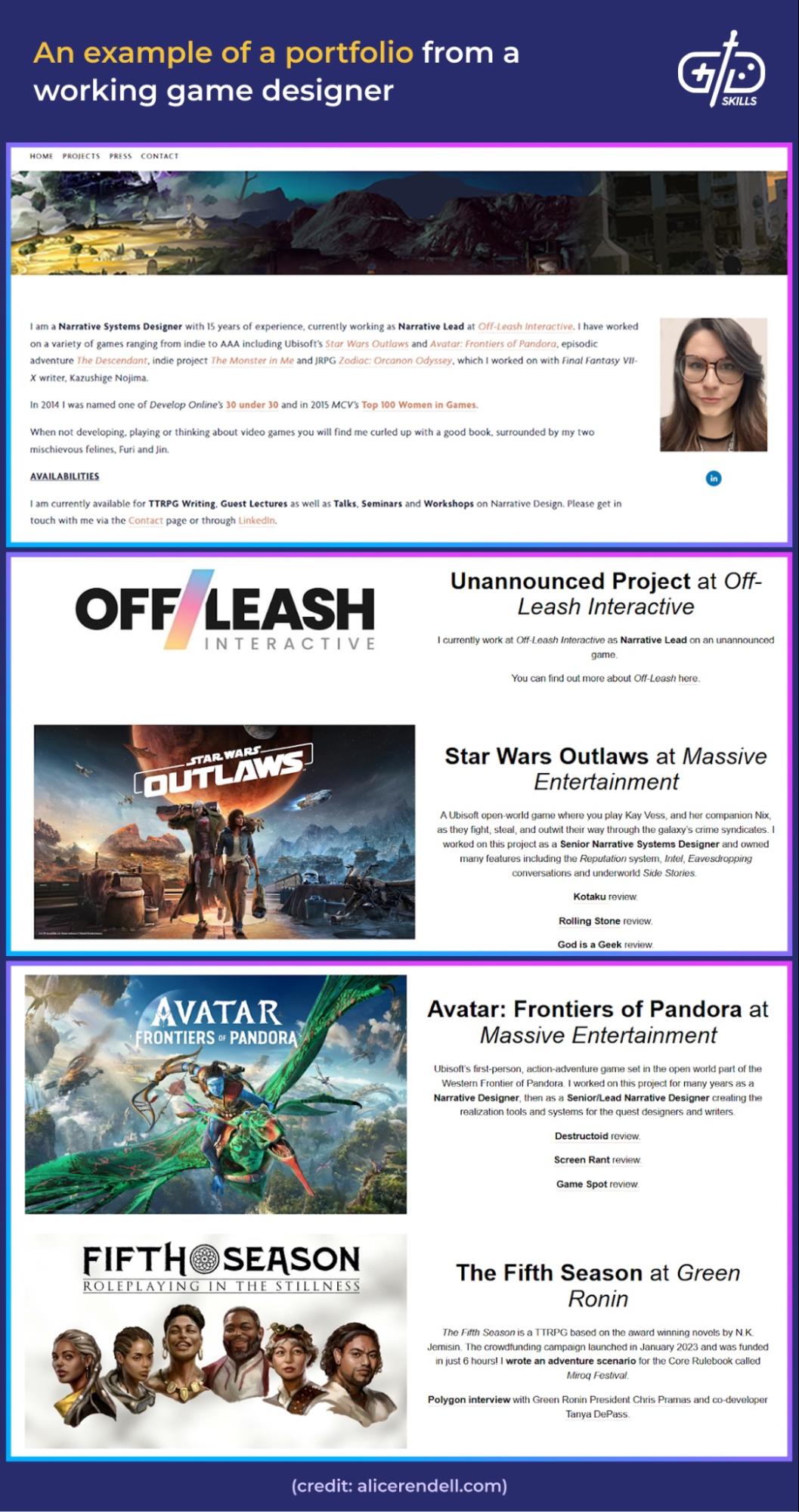
Specific game design storytelling degree courses are uncommon, with many creative writing BA and MA programs including game writing/narrative design as a module. For game designers who want to focus on the visual side of game design, like game art and character design, programs that focus on tools like Maya, Blender, ZBrush, and Photoshop are best. Graphic design and visual communication skills are necessary for those who want to design game UI, HUDs, maps, and other visual elements. Graduates of graphic design or visual storytelling degree programs can pivot to careers in the game industry by learning game engines and studying UI/UX principles for games.
With their focus on interactive storytelling, Interactive Media degrees are useful for those interested in designing UI/UX or working in production roles. For those interested in a master’s degree in advanced study, select a program based on its curriculum, industry connections, and graduate outcomes. MA graduates from USC, RIT, and SCAD achieve high employment rates in the games industry post-graduation.
Is game design a good major?
No, game design is not a good major because students are better served by learning hard skills like software engineering, programming, and computer science. I (and many of my colleagues) learned design skills as we worked in the gaming industry. Having hard skills like engineering and computer science helps students gain entry-level game development positions. Game design is a skill set you learn from bootcamps, YouTube tutorials, game jams, and online game design communities.
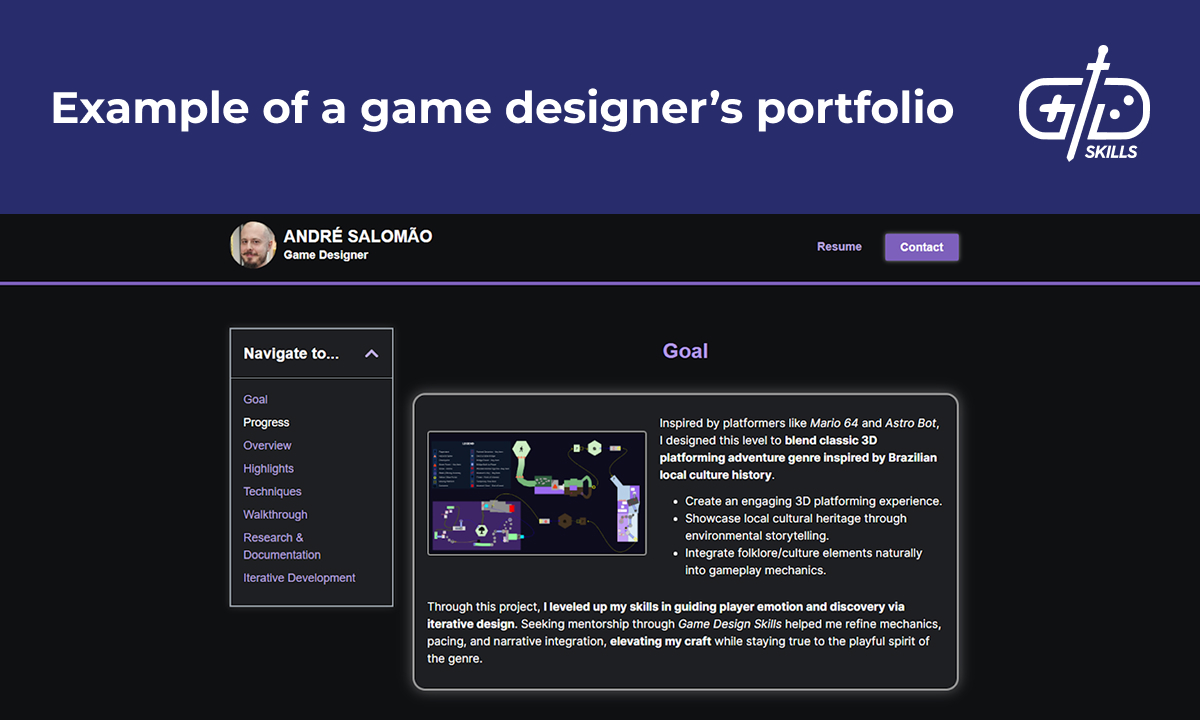
Portfolios are the most important factor for games industry recruiters. A degree from a highly respected university means nothing if not accompanied by a portfolio demonstrating your abilities. Some game design degree accreditations are more valuable than others. For example, USC, RIT, and NYU’s game design degree programs are recognized as worthy, industry-relevant courses. A game design degree helps students develop their portfolios by setting milestones and projects that serve as a form of skill demonstration. The job market competitiveness of the video game industry is such that only demonstrable work gets you noticed.
What are the best video game design programs?
The best video game design programs are USC’s BA in Interactive Media & Games, NYU’s Game Center’s B.F.A., the University of Utah’s B.S. in Entertainment Arts & Engineering, RIT’s B.S. in Game Design and Development, and SCAD’s B.F.A. in Interactive Design and Game Development. Carnegie Mellon University’s 2-year master’s course and DigiPen Institute of Technology’s B.A. in Game Design are also considered elite game design programs.
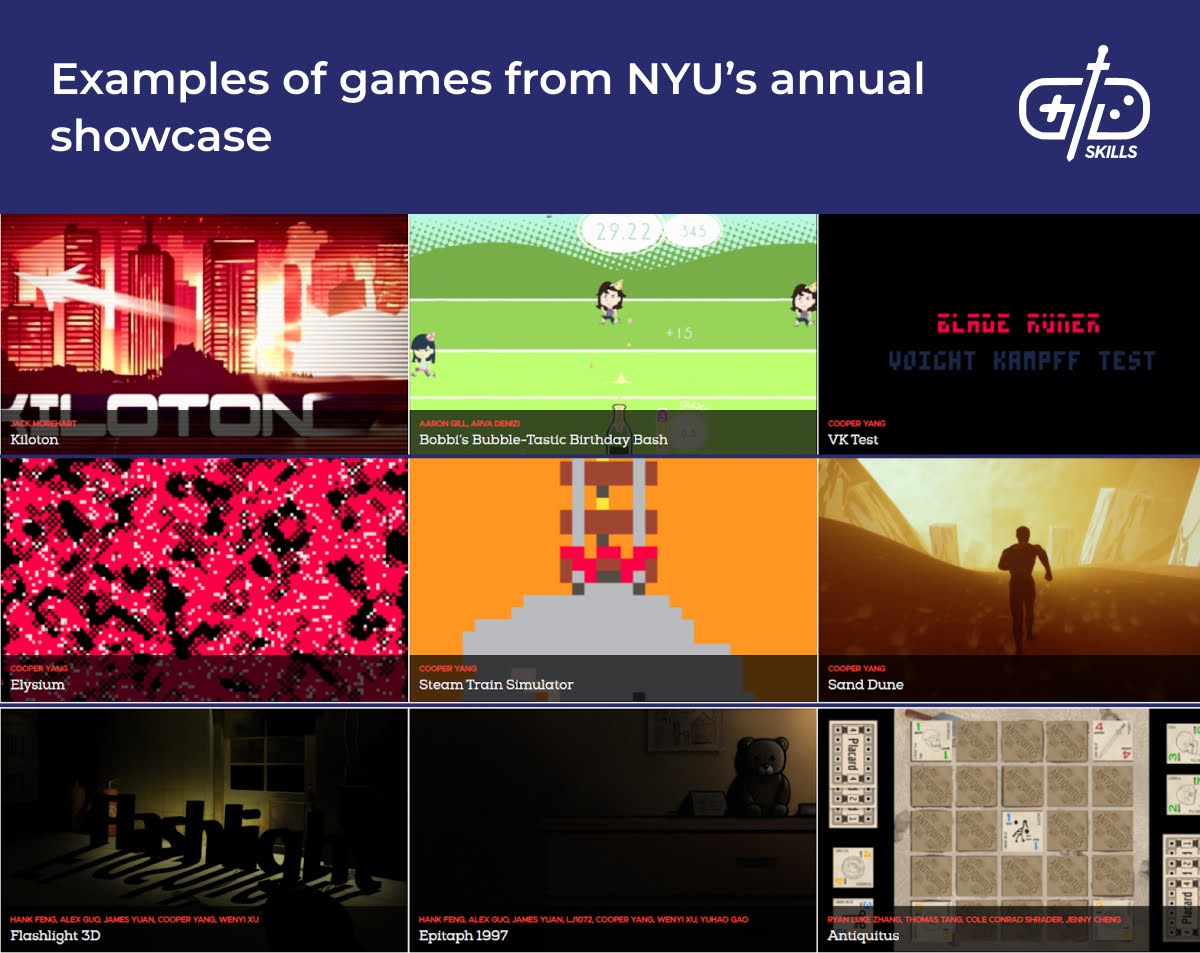
USC’s program consistently ranks among the best courses because it integrates art, narrative, programming, and business. The game design program is a collaboration between the School of Cinematic Arts (SCA) and the Viterbi School of Engineering, making it a unique mix of the technical and the creative sides of game design. USC also features industry-leading instructors and has connections to major companies in the games industry.
NYU’s Game Center’s B.F.A game design program stands out for its focus on experimental, indie, and narrative-heavy games. The program has a reputation for treating games (and their design) as a form of creative expression and not merely as a tech or entertainment field. NYU has deep connections to New York’s growing indie scene, and graduates often find work within the region.
University of Utah’s B.S. in Entertainment Arts & Engineering has a reputation for teaching a full stack of game development skills: game design, prototyping, engineering, digital content, storytelling, ethics, production, and marketing. UU emphasizes project-based learning over its four-year duration, operating as a collaboration between the engineering and fine arts departments. Graduate students from UU’s B.S program.
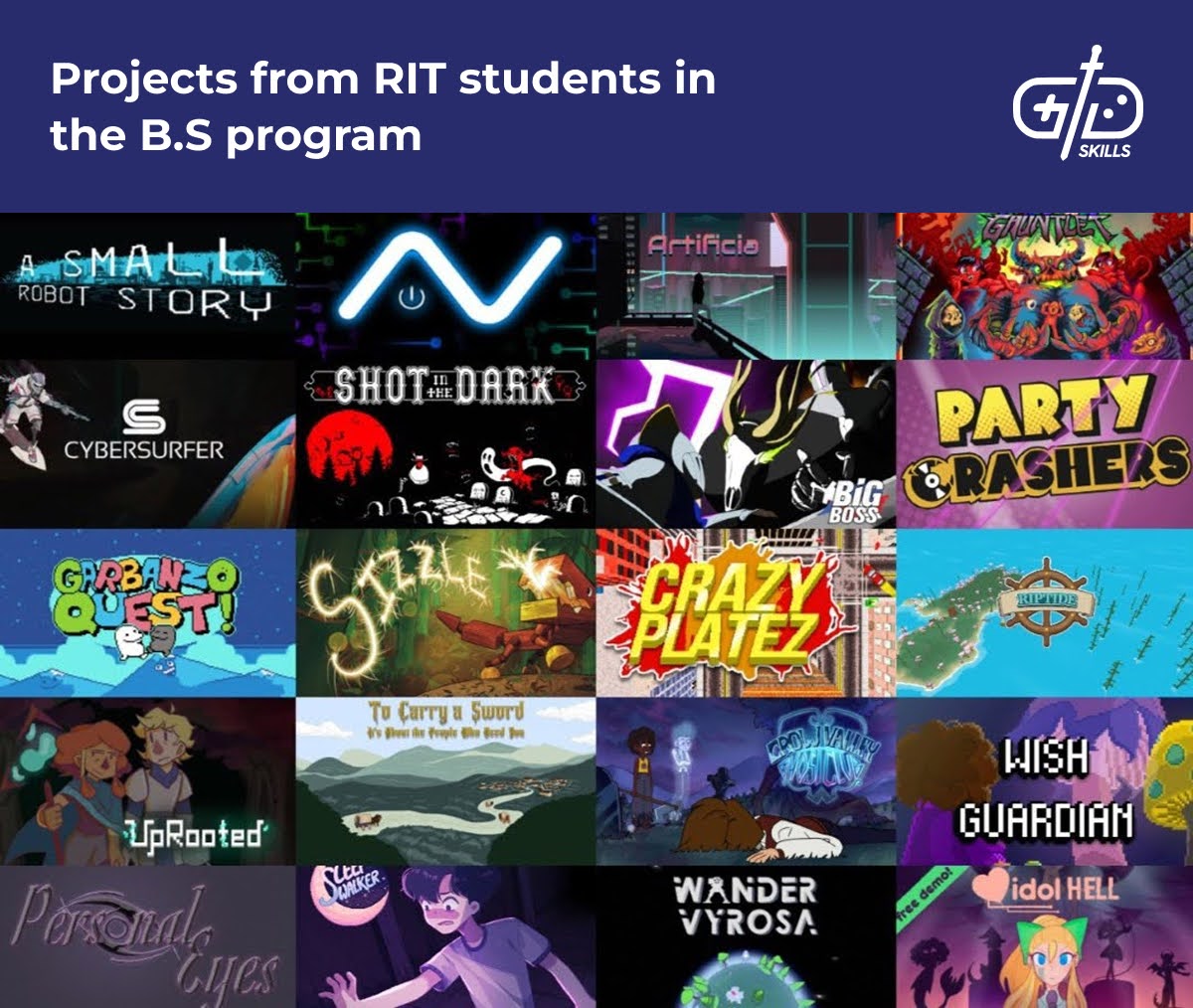
RIT’s B.S. in Game Design and Development blends computing fundamentals with game-specific skills and features several core design modules with elective options. RIT gives students access to MAGIC Spell Studios, a full-scale production environment where they develop and publish their own games in an industry-standard environment. The Game Design and Development program at RIT also provides networking opportunities through its Creative Industry Day event, guest lectures, and portfolio reviews by industry experts.
Carnegie Mellon University’s 2-year Master of Entertainment Technology (MET) is jointly awarded by both the School of Computer Science and the College of Fine Arts, making it a blend of technical and creative study. The focus at CMU is on working at a real-world production level, with projects serving clients like museums, non-profits, and game studios. The project-centric coursework prepares students for CMU’s internship programs with companies like EA, Activision, Rockstar, and Crystal Dynamics. The placement rate to career success rate for graduates of CMU is high, making it an attractive prospect for students looking to enter the industry straight from graduation.
Graduates from the CMU program have created commercial-grade products during the program. One example is Dust to Dawn, an action RPG with a unique light – darkness mechanic.

SCAD’s Interactive Design and Game Development B.F.A. emphasizes visual storytelling, experience design, and game aesthetics over programming and engineering. SCAD ‘s B.F.A. suits students looking to enter the industry as game artists, level designers, narrative designers, and UX designers. SCAD’s program features industry-standard tools, real-world projects, and hosts events like SCAD GamingFest, AnimationFest, and Career Fair to help students enter the industry.
DigiPen Institute of Technology’s B.A. in Game Design focuses on Level Design, Narrative Design, Systems Design, Technical Design, UX Design, and User Research in the first 2 years. Students then narrow their focus to 2 areas and deepen their specialization. The BA has a reputation for mirroring real-world dev cycles, especially in its emphasis on rapid prototyping, playtesting, and collaborative, project-based learning.
What is the difference between game design vs game development?
The difference between game design and game development is that a designer creates a game’s vision from scratch, while “developer” is a broad term that covers anyone working to bring that vision to life, including artists, writers, producers, programmers, sound designers, etc.
Game design is a subfield of game development. Every contribution from every team member is an example of game development.
Game designers primarily focus on why a feature ought to exist and refine that feature in-engine. Game developers bring a project’s vision to life using a mix of programming, engine-specific knowledge, animation, sound design, art, and technical problem-solving. Game designers spend time ideating, prototyping, testing, and refining user experience and engagement.

Note: The public (and games media) frequently conflate the terms “game developer” and “game programmer”. A game developer is anyone working on delivering a video game to the market. Game developers include producers, writers, programmers, designers, marketers, artists, musicians, game designers, and sound designers.
This table demonstrates the core differences between game designers and game developers.
|
Game Designer |
Game Developer |
|
| Primary Focus | Plans and refines how the game plays | Builds the game, allows it to function, creates the art and audio, builds levels, facilitates the entire process, etc |
| Skills | Creativity, storytelling, systems thinking, and UX | Programming, game engines, art, sound, math, debugging, troubleshooting, marketing, QA, etc |
| Deliverables | Game design document, mechanics prototypes, character concepts, world-building docs, etc | Code, game features, art assets, physics, AI, UI logic, audio assets, functional gameplay |
| Goal | Make the game fun and engaging | Make the game stable, look and sound good, and make the public aware of the game. |
What is the video game design process?
The video game design process is a series of steps necessary to efficiently move from planning to testing to production to the polished, commercial release of a video game. Game designers are crucial to the process throughout the 7 stages of game development, but most essential during conceptualization, pre-production, and production when the core concepts, mechanics, and themes have yet to be finalized. The game design team is engaged in each stage of the development cycle in the following ways.
1. Conception: Conception is when the game design team brainstorms ideas about themes, genres, gameplay, mechanics, settings, and the target audience. Once the team has settled on a cohesive set of ideas, they create a pre-production concept design document. This document describes the game’s vision, key features, mechanics, lore, gameplay, and unique selling point. These ideas can be collated into a concept pitch deck to show to potential investors to finance the project.
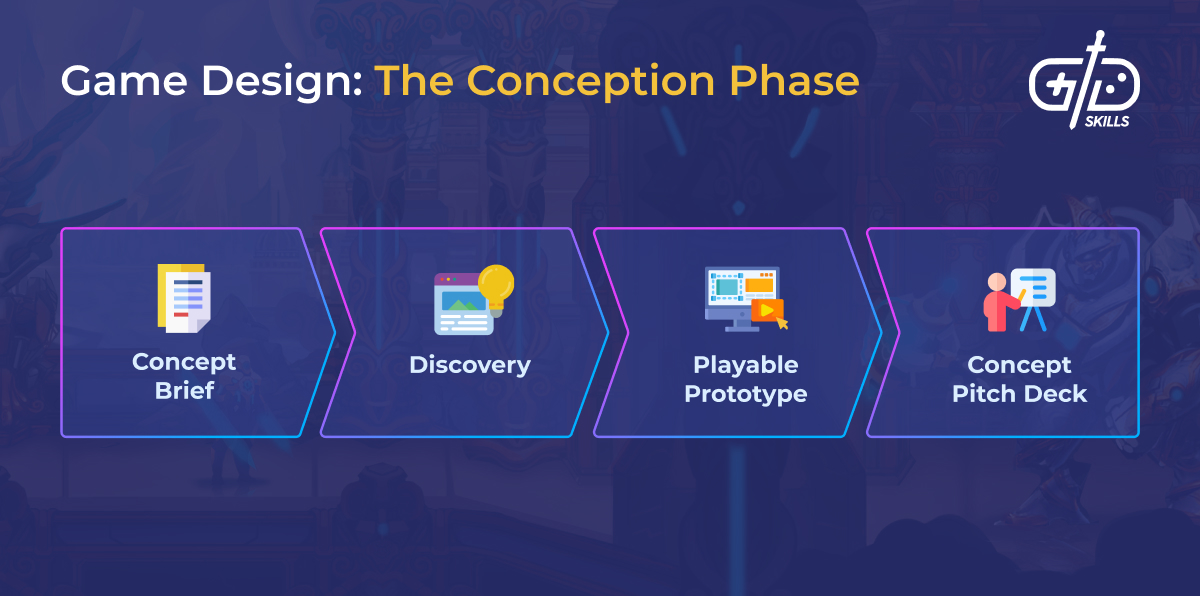
2. Pre-Production: Pre-production is the stage where game designers create a game design document (GDD). The GDD is a detailed document covering story, art design, gameplay, mechanics, characters, factions, UI/UX elements, and any other information central to the game vision. Designers work with other team members at this stage to build quick prototypes to test how fun and feasible their concepts are. Resource allocation is an important part of pre-production, and designers can respond to scaling resources by altering or removing features.
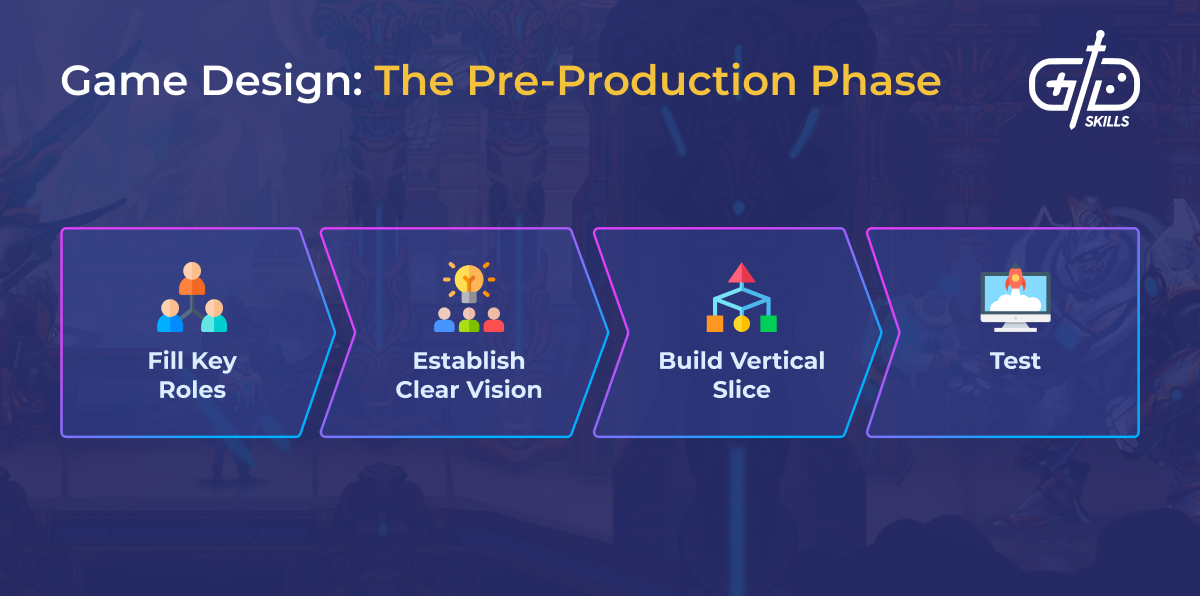
3. Production: Production is when game designers collaborate closely with other developers to implement gameplay features according to the team’s original vision. Designers are hands-on with the project at this point, playtesting builds to check for fun and balance. Designers refine level design, gameplay mechanics, enemy encounters, and AI behaviour during the production phase, while producing and delivering on detailed specs for missions, mechanics, and player interactions.

4. Testing: Testing is a stage where designers work with the QA team during testing to interpret player feedback and respond to bug reports. Feedback from the QA team may require designers to revisit issues related to balance, pacing, or instances where the player is unclear on how to progress. Tutorials, tips, and onboarding sections can be improved and refined at this stage according to feedback. Focus groups can help designers make the game more accessible to disabled people during the testing phase.
5. Launch: Launch is accompanied by a day-one patch that designers work hard to perfect. Game designers work to polish and tune the title for optimal player experience. Day-one patches are a common feature in today’s gaming landscape, and designers work pre-launch to prepare patches or hotfixes based on final playtests. Once the game launches, designers monitor player reactions and check which features are engaged with and which are ignored.
6. Post-Launch: Game designers analyze player data and feedback post-launch to identify areas of gameplay to improve. As more players interact with the game, it becomes clearer to the design team what works for content updates and seasonal events (if an MMO). The live behaviour of the players informs the designers of what needs adjusting. For example, if most players ignore a certain piece of equipment, it probably needs to be tuned or adjusted.
7. Support: The role of game designers during the support and maintenance phase is to design expansions, updates, and work with community managers to respond to player feedback. Game designers tweak and refine mechanics, classes, and abilities to foster long-term engagement.
What are the elements of game design?
The elements of game design are gameplay mechanics, story/narrative, art/visual design, audio design, level and world design, UI/UX, game balance and progression, and multiplayer/social design (if applicable). Game designers must work to transmit the goals, frameworks, themes, and mechanisms that constitute gameplay without breaking immersion. When seamlessly integrated, these elements contribute to the overall user experience of a game while propelling the player forward on their journey. The importance of each design element is listed in detail below.

1. Gameplay mechanics: Gameplay mechanics are fundamental rules and systems that define how players interact with a game. Player actions are the most central mechanic. Mechanics determine how the player runs, jumps, dodges, attacks, explores, and interacts with the world around them. Objectives, goals, and win conditions are a crucial mechanic in video games. Designers decide whether characters take turns, respond to timers, accrue points, or otherwise track their progress. Enemies, puzzles, hostile environments, and resource limitations represent the challenges and obstacles players must overcome. Game designers must carefully design and refine their traps, enemies, encounters, and battles.
2. Story/narrative: Narrative designers create the world, lore, history, factions, creatures, and biomes of your gameworld. Next, designers create the characters, including playable characters, companions, NPCs, antagonists, hostile creatures, mounts, and more. Video game plot structures tend to be linear, branching, or emergent/open. Narrative designers create and refine the best narrative structure and tone for the project. Kelly Bender’s Game Writing Bootcamp is a helpful introduction to narrative design, full of stories from his career as a narrative designer and game writer for Assassin’s Creed Odyssey and 30+ more AAA, mobile, and VR games.

3. Art/visual design: Art/visual design refers to all the aesthetic elements of the game, characters, buildings, wilderness, lighting, weapons, environment, and anything else the player can see. Designers must decide whether the game features a realistic, stylized, cartoon, or pixel art aesthetic. Designers also work closely with animators and the effects team to make sure the movement and visual effects align with the rest of the visual style.

4. Level and world design: Level and world design create the structure and layout of the game world and define how the player navigates it. World maps, levels, buildings, dungeons, and zones are part of the level and world design remit. Game designers must work with the level design team to optimize the flow and pacing of the environment and adjust the pace or order in which they face challenges. Designers can use levels to tell micro-stories or establish themes through environmental storytelling.
5. UI/UX design: UI/UX design defines how players interact with the game’s systems is a result of its UX/UI design. Health, ammo, and stamina are often part of the heads-up display (HUD), and designers must make these elements easy to read without distracting from the action. Inventory, maps, character progression screens, and options are accessed through menus that designers optimize for ease of navigation. Feedback systems transmit player input into tangible onscreen action through visual, audio, and tactile responses. Game designers must balance and optimize these systems so players feel a visceral connection to the experience.
6. Balance and progression design: Balance and progression design is the art of making challenges and systems that are fun, fair, and rewarding. Balance and progression design is the process of making players feel appropriately rewarded for the time and effort they put into a game. Difficulty scaling is an area where game designers must balance an evolving challenge with the risk of player frustration. Items, story content, characters, and abilities must unlock at an appropriate pace to keep players engaged. Crafting, trading, upgrades, and in-game currency must feel meaningful and reward players for perseverance, creativity, or experimentation.
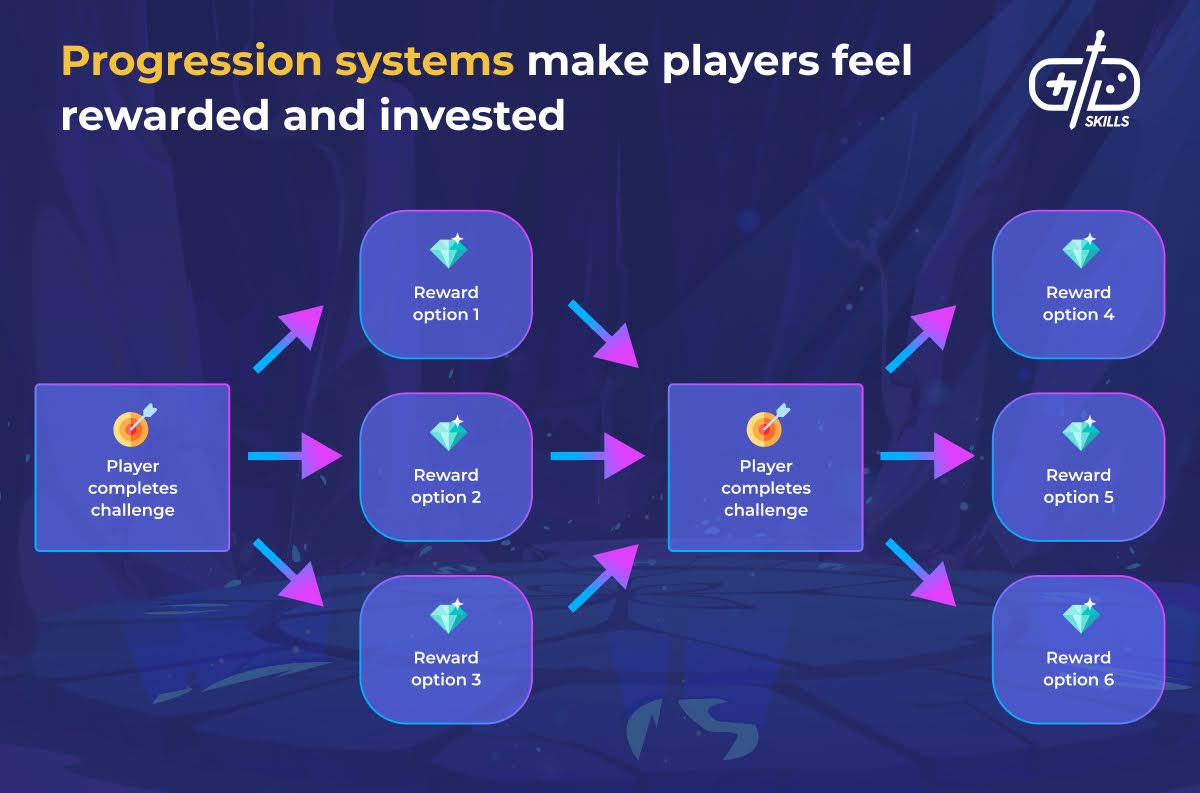
7. Multiplayer/social design: Multiplayer/social design refers to creating co-op modes, versus modes, match-making capabilities, lobbies, and social features like text chat, voice chat, guilds, clans, leaderboards, and marketplaces. Effective design of these features leads to broader adoption of a game and fewer dropouts due to frustration.
What is the history of game design?
The history of game design stretches back to 1947 and the invention of the first human-screen interaction for entertainment, the Cathode Ray Tube (CRT) Amusement Device. The CRT Amusement device was pioneering, but also a false start, having never gained public notice or gone into manufacturing. Interactive, computer-powered puzzles like Bertie the Brain, Oxo, and Nimrod played tic-tac-toe and the mathematical game Nim with the public in the 1950s.

Innovator William Higinbotham invented the first interactive, real-time video game with graphics in 1958 with his two-player Tennis for Two game, played on an oscilloscope using a custom dial-and-button controller. Research institutions and universities in the 1960s housed mainframes and microcomputers where students and faculty programmed games after hours. Spacewar! from 1962 was the most enduring and popular of these ’60s games, featuring two ships locked in a dogfight around the gravity well of a star (that description sounds epic considering it’s several monochromatic dots on a tiny screen.) Spacewar! was shared around multiple institutions and influenced the nascent video game industry.
Another pioneer, Ralph Baer, was inspired by how the military used television sets as interactive display systems in the 1960s. He realized that with 40 million TV units in the USA, additional home uses of the TV set become lucrative. He created a prototype called the Brown Box in 1967, which included ping-pong, checkers, four different sports games, and target shooting featuring a light gun. The Magnavox company licensed the Brown Box in 1972 and released it as the Magnavox Odyssey. Video gaming’s first mega hit, Pong, also arrived in 1972. Alan Alcorn created Pong in 1972 as a training exercise set for him by Atari company CEO, Alan Bushnell. Magnavox later sued Atari for copyright infringement over Pong’s similarities to the Odyssey’s ping pong title. The game design that disrupted the coin-operated gaming industry and raised the profile of video games internationally was Space Invaders from 1978.
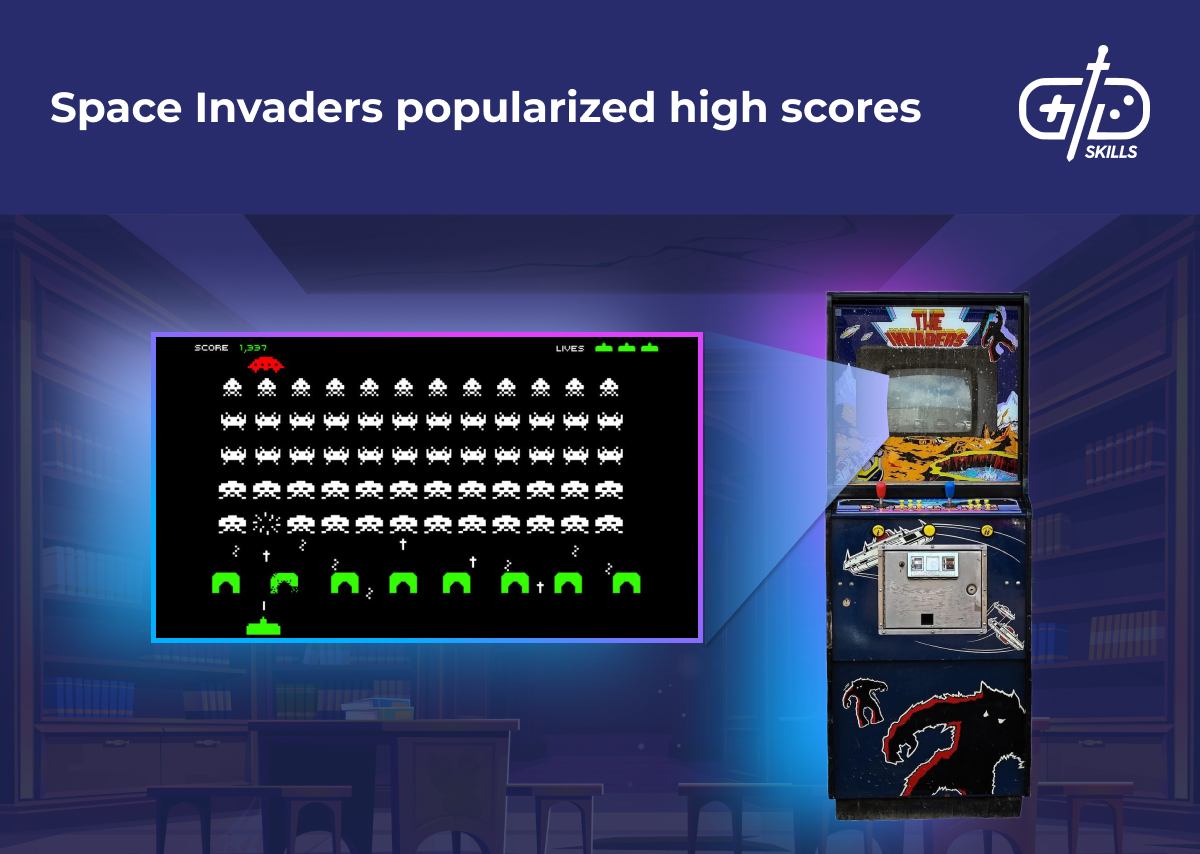
Space Invaders popularized the concept of playing for a high score, featured music that reacted to player action, and had a massive influence on video gaming and culture in general. Arcade shooters had existed before, but Tomohiro Nishikado’s Space Invaders became a cultural phenomenon, selling many cabinets and becoming the first killer app for a console when released for the Atari 2600. The Pac-Man arcade game was video gaming’s next biggest hit. Created by Namco in 1980, Pac-Man was the first mega-popular video game with a recognizable main character. Subsequent arcade hits often featured named characters like Donkey Kong, Q*bert, and Frogger, becoming gaming icons that crossed into mainstream media in the Saturday Supercade cartoon.
How can I study game design?
You can study game design by enrolling in a formal course like a university program, a community college course, or an online course. Formal courses range in duration from weeks to years, and range in cost from free to thousands of dollars. Game design bootcamps are a way for you to study real, practical design skills under working professionals, while internships allow you to develop industry connections and experience. Bachelor’s degree program accreditation is less important in the game design field than in other industries. That’s not to say you can’t learn valuable skills on game design degree courses, but your portfolio remains the most important factor in your job search. Location and the reputation of the college are worth considering. Tech hubs with game dev scenes offer more networking opportunities.
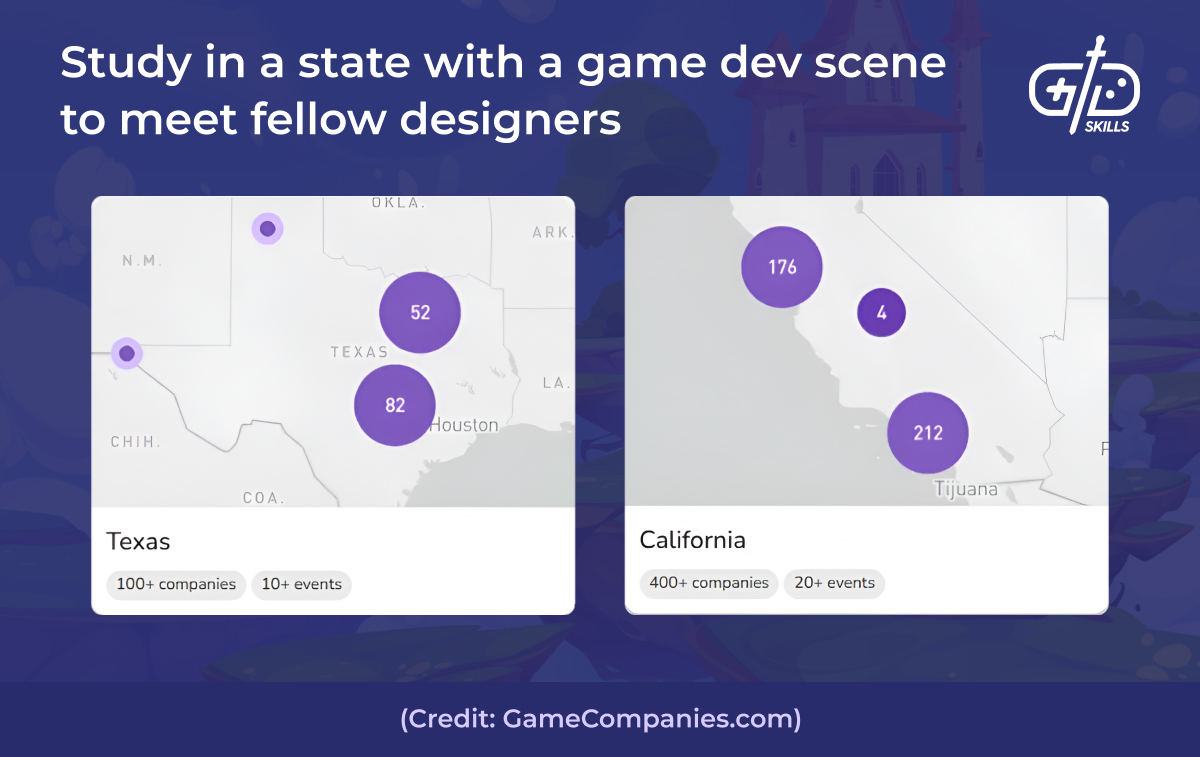
Associate’s degree programs are usually 2-year courses offered at community colleges and online universities. Associate programs are useful only if they help you work towards a coherent portfolio showcasing your design skills. An associate’s degree program’s affordability makes it an attractive option for those with little experience, but using free online resources and attending some project-led game design bootcamps can make it cheaper and more efficient.
Master’s Degree programs in game design offer a level of specialization suitable for professionals already working in the games industry looking to upskill, or developers from other areas changing lanes. Mentorship is an effective way to quickly level up your game design skills by learning from more experienced professionals. Networking, game jams, and industry meetups are great ways to meet game devs. Many in the industry are passionate about mentoring the next generation of game designers. I was lost until my mentor Tom Cadwell started to guide me in the right direction. His input helped me develop the skills that got me hired by Blizzard.
What are game design systems?
Game design systems are the interlinked rules, mechanics, and structures that define how a game is played, what constitutes success or failure, and shape the players’ experience. Design systems are collections of self-contained mechanics that interact with other systems (dialogue, progression, combat) to create balanced, engaging gameplay. An example of a game design system (namely, a progression system) principle is the isolation principle.
Game designers realized over the years that players become frustrated when they aren’t given space and time to learn new rules and master new challenges. The isolation principle states that designers must introduce new enemies, obstacles, or techniques in controlled environments. In this way, players can get familiar with new rules, systems, movements, or challenges without feeling overwhelmed or stressed. Use of the isolation principle in progression systems reduces the incidence of rage quitting. Other types of game design systems are listed below.

1. Combat systems: Combat systems are the factors that determine how fighting works within your game. Designing this system starts with high-level considerations like whether to go turn-based, real-time, action, realistic, slapstick, first-person, third-person, overhead, etc. Does combat resolution involve ranged, melee, magic, or a mix of all three? Combat design encompasses how damage works, what tactics are viable, and what factors influence hits and misses.
2. Scoring systems: Scoring systems are how we keep track of successes in multiplayer games and of leaderboards in single-player experiences. The inclusion of a scoring system is taken as a given by this point in the evolution of games, but it was once a novel concept. Pong from 1972 was the first game to feature a scoring system. Space Invaders from 1978 was the first game to popularize playing for a high score.
3. Progression systems: Progression systems are what compel players to continue by increasing the skill challenge in line with increased player competency/level. When a game feels challenging without frustration and guides players forward without friction, its progression systems are working. The isolation principle is a way of putting guardrails on advancement that helps players understand new features. Other types of progression systems include skill trees, unlocks, crafting and brewing systems, and level-gating.
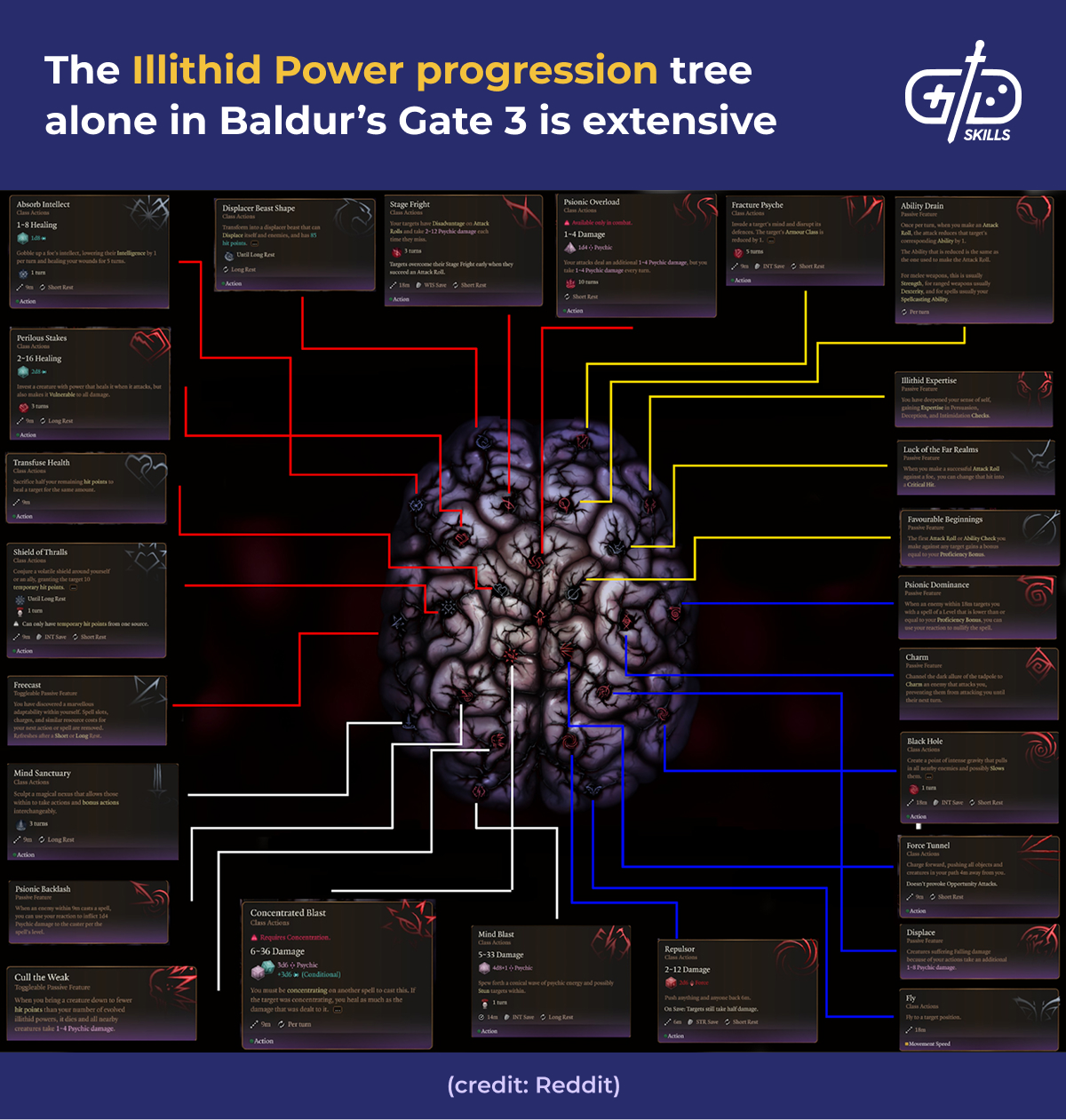
4. AI systems: AI systems are the systems governing the behavior of all hostile and friendly NPCs. Game designers work closely with AI programmers to make the behavior of the NPCs reflect the game’s vision and themes. AI systems determine things like enemy/companion pathfinding, adaptive difficulties, and enemy tactics.
5. Dialogue systems: Dialogue systems are how you interact with NPCs in the game. In narratively simple, linear games (for example, mobile games), navigating the dialogue can be as simple as clicking to progress the discussion. In more complex titles like AAA console and PC RPGs, dialogue can be branching with interconnected reputation and morality systems.
6. Economic systems: Economic systems are the factors governing what players can buy, sell, and trade, and determine how players interact with resources, currencies, and rewards. Effective economic system design gives players objectives to work towards, and makes foraging, crafting, and visiting NPC vendors a rewarding process.
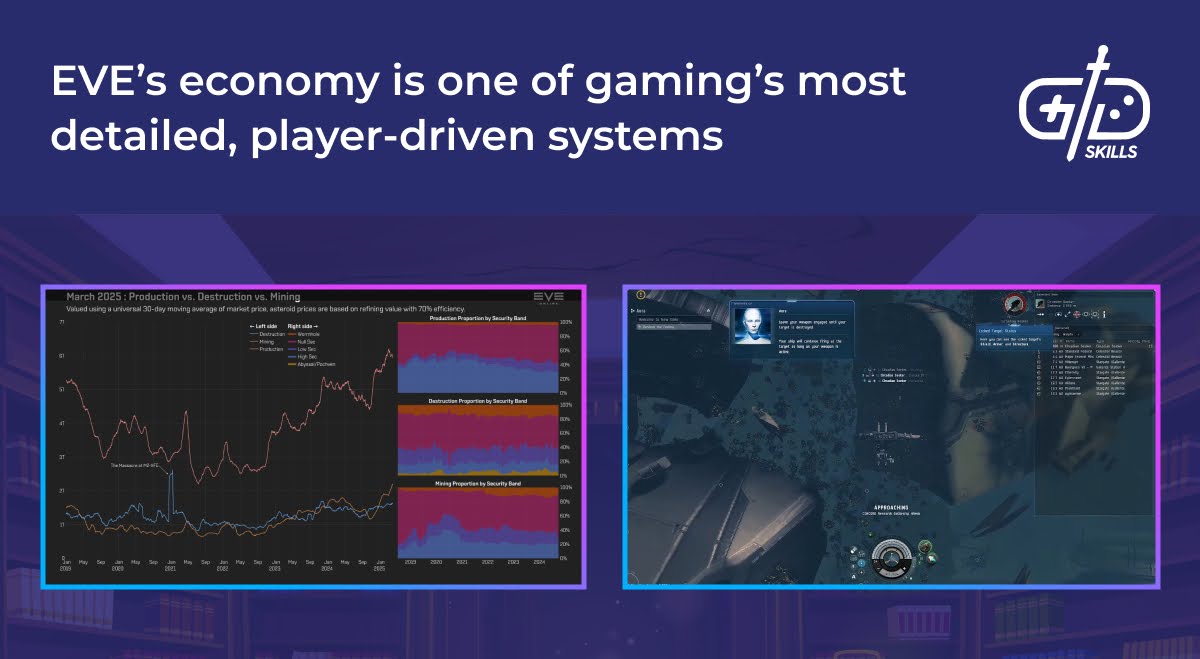
7. Quest systems: Quest systems are the apparatus that players interact with to initiate, execute, and resolve missions and objectives within the game. For example, many RPGs are designed with a main quest/side quest dichotomy that helps players focus on what’s important to them. Other games feature emergent, dynamic events that trigger when the player is within a certain proximity. Game designers must carefully balance and refine these systems to maximize player engagement and retention.
What are the basics of game design?
The basics of game design are a combination of storytelling, systems thinking, user experience, and technical skills that allow for the creation of an interactive experience. Students can learn basic game design principles by prototyping game designs with pen and paper. The game concept is the most basic foundation of a game, describing what the game is about and how players experience it.
The first step in defining a game concept is the core idea or elevator pitch. Examples include “A fast-paced 2D puzzle platformer on an industrial planet” or “An open world action RPG set in a post-nuclear wasteland” (someone got to that one first!). The core idea is a one or two-sentence summary of the highest-level features of the game. Next, consider genre. The genre of the title sets player expectations and defines what kinds of systems and mechanics the game contains. Designers determine if the game works best as an RPG, FPS, third-person action game, or RTS. Here’s a slide including the elevator pitch from the pitch deck of an unreleased project I worked on:

Setting and theme are fundamental elements of game design. As an exercise, think of a game you love and quickly establish its setting and theme. For example, The Witcher 3: setting – The Northern Realms, theme – destiny vs free will, and family. The Witcher 3’s grim, European fantasy-inspired setting synergizes with its themes of destiny as players face existential threats and archetypal horrors in their search for an adopted daughter. This kind of synergy between setting and theme makes for more emotional storytelling and fosters connections to the players’ life experiences.

Fallout 4 is another example of theme and setting working together. Its post-apocalyptic setting and its theme of survival and family loyalty make the crafting, base building, and scavenging hit on multiple levels. The wasteland is lonely, so tracking down your remaining family member by building alliances and bases works. Great games have settings and themes that combine with mechanics, systems, and narratives to compel players forward. Next, consider core mechanics. Decide how the player navigates and interacts with the game world and its denizens. Running, jumping, climbing, combat, building, dialogue, and stealth are examples of core mechanics in video games. Consider which ones best serve your game concept.
Games revolve around their players, so game designers need to consider player roles. Consider if players become stealthy hackers looking to free humanity from an autocratic technocracy, plucky halflings tasked with a mission beyond their understanding, or relentless warriors hellbent on revenge. RPGs are often created such that the player can create their own character and class, but their narrative design is typically consistent for every player (with potential branching paths).
Establishing the target audience is another foundation of game design. Consider what the market looks like for similar products. Visualize who you expect to be a day-one customer for your product. The final part of your basic game design is its unique selling point (USP). The USP is the element that makes your product stand out and appeal over competing experiences. For example, The Legend of Zelda: Tears of the Kingdom’s unique selling point was its Fuse and Ultrahand abilities, allowing you to build virtually anything you can think of.

What are some good game design courses?
Game design courses that teach industry-relevant, in-demand skills and offer practical advice on entering the industry are the best choice. Bootcamps like Game Design Skill’s game mechanics, narrative design, and level design courses feature veteran instructors who understand what recruiters look for in new hires. By teaching through project-based lessons, these courses equip students with new skills as well as portfolio pieces to showcase their abilities. Courses like those from Game Design Skills stand out because they focus on preparing students for the realities of working on games and the skills that are required.
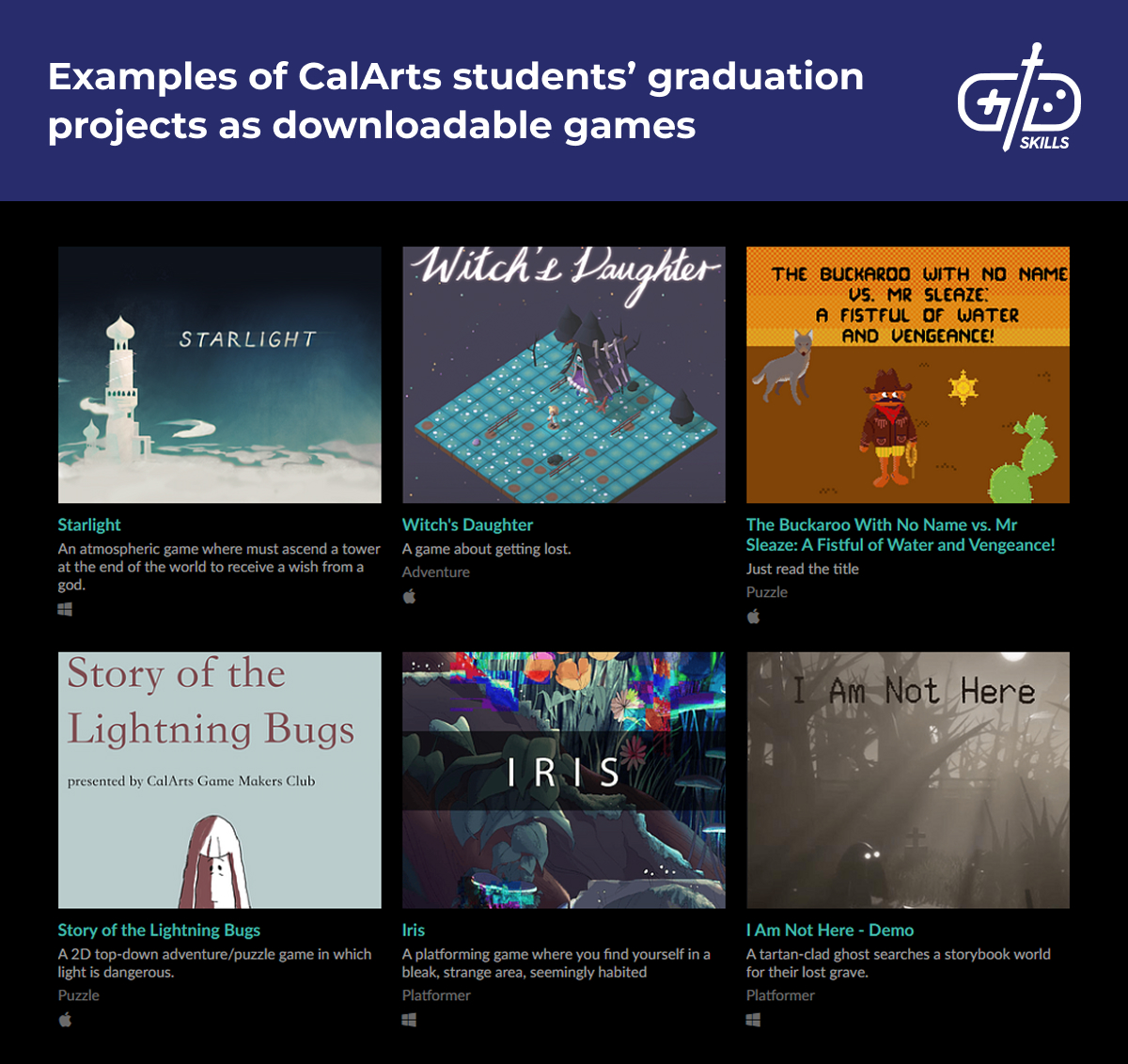
The California Institute of the Arts’ degree programs, Michigan State University’s BA in Games & Interactive Media, Epic Games Unreal Engine courses, and Unity tutorials are examples of quality game design courses. The first two are full-time degree programs costing many thousands of dollars, while the second two are offered free on their host platforms.
Engine training modules like Unreal Engine game design tutorials or Epic Games training resources help you to prototype and test design ideas effectively. Coursera’s Game Design and Development Specialization is offered through Michigan State University and is a highly-rated, inexpensive course that teaches Unity skills and game design principles. It’s a good place to start for those looking to dip their toes in game design for the first time.
Digipen Institute of Technology features BA and BS programs in game design that focus on pure game design in the former and technical design in the latter. Savannah College of Art and Design’s game design curriculum is renowned for its focus on art and production. Rochester Institute of Technology degree programs teach a BS that focuses on programming and mechanics. Udemy video lectures and edX university courses also offer inexpensive game design courses that students can complete at their own pace.


